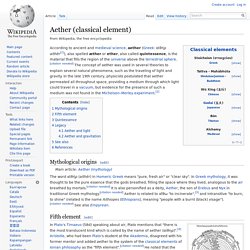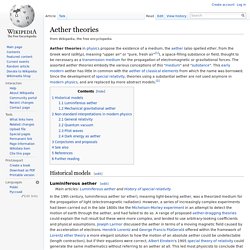

Earth song sound - NASA recording -real. Aether Theories - Collation of Modern Scientific Theories of the Ancient Aether. Aether (classical element) According to ancient and medieval science, aether (Greek: αἰθήρ aithēr[1]), also spelled æther or ether, also called quintessence, is the material that fills the region of the universe above the terrestrial sphere.

[citation needed] The concept of aether was used in several theories to explain several natural phenomena, such as the traveling of light and gravity. In the late 19th century, physicists postulated that aether permeated all throughout space, providing a medium through which light could travel in a vacuum, but evidence for the presence of such a medium was not found in the Michelson–Morley experiment.[2] Medieval concept of the cosmos. The innermost spheres are the terrestrial spheres, while the outer are made of aether and contain the celestial bodies With the 18th century physics developments physical models known as "aether theories" made use of a similar concept for the explanation of the propagation of electromagnetic and gravitational forces.
Aether theories. Historical models[edit] Luminiferous aether[edit] In the 19th century, luminiferous aether (or ether), meaning light-bearing aether, was a theorized medium for the propagation of light (electromagnetic radiation).
